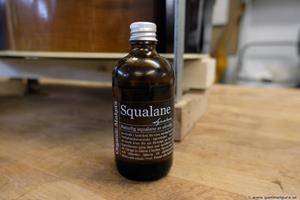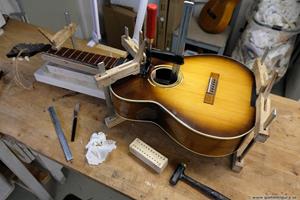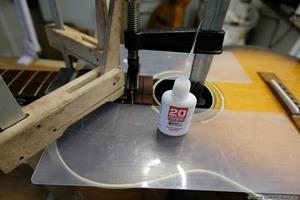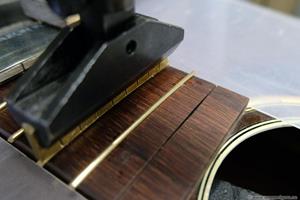Got tips about this "oil" for fretboards and stables on the American Martin forum. In quotation marks when it is not about an oil or a wax, but a chemical substance found in the oily surface of human nose 🙂 That substance is squalene with 'e', squalane with 'a' is a refined variant that does not rancid or gets bad.
This substance has been used in all times for various purposes. When scanning old dia slides you could get rid of scratches, fishermen rub the metal sleeves between the different parts of the rod against the nose, wooden smoking pipes could be conditioned with a little "nose oil". Squalane, most commonly made from olive oil, is now used in many cosmetic products such as moisturizer and to protect and lubricate the skin . .
It is quite expensive, but you only need to moisten a fingertip to cover 4-5 frets on the fretboard or half a bridge. I bought my bottle from Organic Makers.
This is now the last treatment I give fretboards and bridges. The color of the wood deepens and the surface is smooth and comfortable to the touch - even. good for the skin! I think it can possibly protect the board from drying out too, it is at least the function on the skin in the cosmetic creams.
But interestingly, it has a different use. Superglue has a tendency to end up where you do not want it, especially the thin-liquid variant. I have previously used wax to protect the fretboard when I superglue frets when refretting, but what happens is that the glue is quickly activated by the wax and you get a white and hard crust that can sometimes be difficult to remove. Squalane does not activate superglue in the same way, it can lie on top of the film of squalane for a few seconds before it corrodes through both the film and any varnish underneath. Not long, but long enough to wipe it off with a paper towel. Squalane also significantly reduces the risk of gluing down the fingers when gluing sensors for a K&K pickup by wetting the fingertips with squalane - very good! I took some pictures while mounting frets in my plank jig
I use semi-tough Stewmac super glue to glue the frets in addition to pressing the frets into the groove.
I fill the bottom of the notch with glue using the thin pipette on the bottle.
The "hot dog with ketchup and mustard" effect causes some glue to pop out when the frets are hammered in. The glue settles on top of the Squalane film on the fretboard without being activated or hardened (at the far end of the picture).
Quick rescue with a piece of paper!
I admittedly missed a small spot, but the rest disappeared without a trace.







